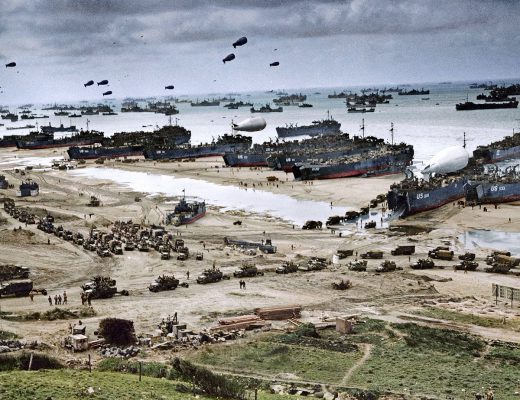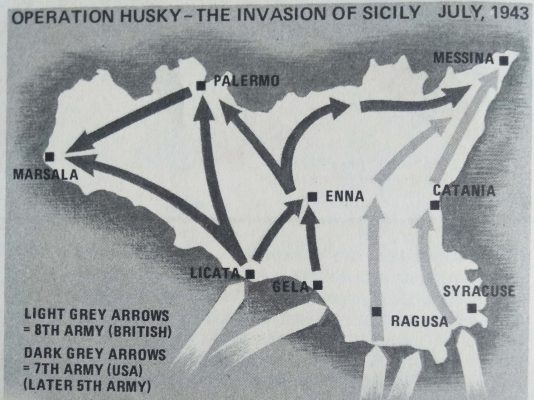
For five long, bitter years of hardship and austerity, the oppressed peoples of Europe had been waiting eagerly for D-Day. By the early summer of 1944 everyone knew it was very near, but no one knew exactly when it would be.
For D-Day, the day when the Allied armies would set out from southern England to invade and liberate the German-occupied continent of Europe, had to be a total secret. The ‘‘D’’, in fact, stood just for ‘‘Day’’!
All that Spring, the fields, woods and lanes of Britain’s southern counties had been filling up with troops, guns, tanks, lorries — all the paraphernalia of modern war. There were soldiers who had escaped from their occupied homelands, and Americans; Canadians, Britons, Australians, New Zealanders, men from every corner of the free world.
All were waiting for The Day — D-Day.
At their head was the quiet, confident American Supreme Commander, General Dwight D. Eisenhower, who had come to England in 1942 as commanding general of all American forces in European areas. For months, ‘‘Ike’’, as he was called, and ‘‘Monty’’ — Field Marshal Bernard Montgomery, his British second-in-command — had been planning for D-Day.
Strangely, at this most important moment in the story of the war, everything depended upon the weather. Among other things, a later-rising full moon was needed to allow airborne forces to approach the invasion zone on the coast of northern France in darkness, and then to give them moonlight to help identify their dropping zones. And the tides had to be right for the seaborne armada, taking the bulk of the infantry who would storm the beaches.
In May the weather was splendid, but the omens were bad. Depressions and gales were imminent, as Group Captain Stagg of the R.A.F., who was the chief weather expert on the planning staff, warned Eisenhower.
As June dawned over southern England, the generals in their secret headquarters put all the facts together and decided that the invasion of Europe had to be between the fifth and seventh of June. This was not just because of the tides and the moon. It was known that the Germans were about to launch secret weapons on London — the V1 “flying bombs’’ and V2 rockets — and their bases had to be captured and destroyed. It was vital, too, for the invading army to break out from the invasion zones and set out for Berlin, the German capital, long before the winter came.
On June 4th the weather was terrible. With a heavy heart, Eisenhower decided that the invasion must be postponed for 24 hours, an awful decision to make and a dreadful strain on the waiting troops.
The next correct tides after June 7th were not for a fortnight. So everything now pointed to June 6th as D-Day.

Learning the art of invasion
Before D-Day had been thought of, the Allies had undertaken several invasions and had learned something from each of them. Operation Torch, or the invasion of North Africa in 1942 was then the greatest invasion the Allies had ever attempted and it took the Germans by surprise. On the 8th November, 1942, over 1,000 aircraft, 200 warships and 350 merchant ships carrying 70,000 troops attacked three north African targets — Algiers, Oran and Casablanca. For the first time, an American, General Dwight Eisenhower, was made Supreme Commander with three British commanders under him. This proved a highly-successful arrangement.
The assault on Siciliy — Operation Husky — in the following year posed different problems. This time, the Germans were prepared for the ‘invasion and were dug in to resist it, so landings had to be accurate, fast and with a rapid build-up of highly-trained troops. Altogether, 160,000 men, 14,000 vehicles, 600 tanks and 1,800 guns were landed. Three thousand aircraft and 3,200 ships lent support and by the end of August, 1943, Sicily had fallen to the Allies.

It was raining heavily and a gale was blowing on the fifth when Eisenhower asked Group Captain Stagg for new weather report. The reply brought a great surge of relief and anticipation. There would be a fair period which would last until the afternoon of the sixth.
Now it was up to Eisenhower. He had to be sure of something as uncertain as a weather report to make one of the most dramatic decisions in history. Quietly he spoke the momentous words of the war: ‘‘O.K. We’ll go.”
That Stagg was proved right was later history. Some days afterwards a violent storm hit the beachheads in the invasion zone, but by then it didn’t matter.
Shortly before midnight on June 5th, the familiar drone of hundreds of aeroplane engines above the south coast of Britain caused people to lift their black-out curtains (it was still forbidden to show a light, for fear it might be spotted by enemy aircraft) and peer up at the sky. For months the noise of Allied bombers going out and ‘later returning had been heard in the night-sky, but this time it seemed to be much louder.
And indeed it was.
All that Spring the Allied aircraft had been blasting German gun-sites, destroying airfield runways and demolishing bridges all over northern and western France. Some of the attacks had been made hundreds of miles from the intended invasion area, so that the enemy would have no idea where they would be hit on D-Day.
During May alone the Anglo-American air forces unloaded 20,000 tons of bombs on France, systematically destroying communications between the German coastal armies and their bases farther inland. Fifty out of 82 main rail centres were destroyed and 25 more were damaged.
But by June 5th, the invasion count-down had begun. The planes which the southern English could hear extra loudly that night were 1,300 strong, and they were going to blast ten coastal batteries between Le Havre and Cherbourg.
In British airports all the way from Devon to Kent, paratroops, with emergency rations, were already boarding the gliders and transport planes which, within an hour or two, would spill them out all over the Cherbourg peninsula and the country around Caen — the area where the D-Day invasion would strike. (Click here to See the Map)
More than a thousand ships of all sizes, from giant liners to dirty tramps and small coastal craft, filled every harbour, packed to the gunwales with machinery and plant for sowing the seeds of freedom on French soil — tanks, guns, ammunition boxes, shells, wagons, medical supplies, food, repair outfits, all loaded according to carefully arranged schedules, so that first things needed might be the first available. Under the hatches, nearly a quarter of a million men sprawled and talked and smoked and slept.
There was nothing more for Eisenhower to do. The whole gigantic war machine had been set in motion. He decided to go and visit some of his men, and he chose an airborne unit.
He stood, hands in pockets, looking up at the sky as, one by one, the ’planes moved off down the runways and climbed slowly into the night. It was midnight when the last ’plane took off, carrying the American 101st. Airborne Division.
Softening up the enemy :
Between half past five and eight o’clock on the morning of D-Day, the Allied fleets bombarded the French coast to pave the way for the landings to come on the five main beach-heads — nicknamed Utah, Omaha, Gold, Juno and Sword.


It was the 6th June, 1944 — the day when the Allied invasion of Normandy was to begin. Months of secret planning had been spent on the operation. Thousands of troops, ships, aircraft and guns had been organised to take part and were standing by, waiting for the order which would send them across the English Channel to France. Once the invasion had begun, there was no going back. It had to succeed — the whole outcome of the Second World War depended on it.
There were several key events that led up to the decision to carry out D-Day during World War II. Here are the main factors:
-
Strategic planning
After the Allied forces successfully invaded and liberated Italy in 1943, attention turned towards planning a major invasion of Nazi-occupied Western Europe. The Allies believed that a cross-channel invasion, bypassing the heavily fortified German Atlantic Wall, would be necessary to defeat Germany.
-
Casablanca Conference (January 1943)
During this conference, Allied leaders, including British Prime Minister Winston Churchill and American President Franklin D. Roosevelt, decided to escalate the war by demanding Germany’s unconditional surrender. They also agreed to plan for an invasion of Western Europe, aiming for 1944.
-
Operation Overlord
The codename for the D-Day invasion, Operation Overlord, was finalized in 1943. The plan involved a large-scale amphibious assault on the beaches of Normandy, France. General Dwight D. Eisenhower was appointed as the Supreme Commander of the Allied Expeditionary Force.
-
Diversionary operations
To deceive the Germans and divert their attention away from the actual location of the invasion, the Allies conducted a series of diversionary operations. This included the creation of a fictitious army, led by General George S. Patton, which misled the Germans into believing that the main invasion would occur at the Pas de Calais region.
-
Weather considerations
The weather played a crucial role in determining the date for D-Day. Initially, the invasion was planned for May 1944, but due to poor weather conditions, it was delayed until June 6, 1944. General Eisenhower made the final decision to launch the invasion despite the unpredictable weather.
-
Operation Fortitude
This was a comprehensive deception plan aimed at misleading the Germans about the invasion’s timing and location. Fake radio traffic, dummy tanks, and aircraft were used to make the Germans believe that the main attack would come at the Pas de Calais, rather than Normandy.
-
Overwhelming force buildup
The Allies spent several months building up a massive force in England, including troops, equipment, and supplies. This buildup was crucial for the success of the invasion as it allowed for a large-scale assault and the ability to establish a beachhead.
These events, combined with extensive planning, preparation, and coordination among the Allied forces, culminated in the decision to carry out D-Day, which ultimately marked a significant turning point in World War II.
There were several challenges and obstacles faced by the Allied forces on D-Day, which was the large-scale invasion of Normandy on June 6, 1944, during World War II. Some of these challenges were as follows:
- 1. German defenses: The German forces had heavily fortified the coastline with obstacles like beach obstacles, barbed wire, mines, machine guns, artillery, and bunkers. Overcoming these defensive positions was one of the biggest challenges.
- 2. Weather conditions: The initial plan for D-Day had been set for June 5, 1944, but was delayed by one day due to poor weather conditions. Even on June 6, the landings faced rough seas, strong winds, and heavy fog, which complicated navigation and made the assault riskier.
- 3. Surprise factor: The Allied forces needed to surprise the German forces with the invasion to gain an advantage. Maintaining secrecy and surprising the Germans was a significant challenge in the months leading up to D-Day.
To overcome these challenges, the Allies implemented various strategies and tactics:
- 1. Extensive planning: The invasion was meticulously planned for months, focusing on coordination, intelligence gathering, and choosing the appropriate landing sites. Detailed reconnaissance missions, aerial bombings, and naval bombardments were conducted to weaken German defenses and destroy obstacles.
- 2. Deception operations: The Allies initiated a massive deception campaign called Operation Fortitude. This included creating a fictional army and surrounding disinformation to mislead the Germans about the actual landing location, diverting their attention from Normandy.
- 3. Air and naval support: The Allies utilized an enormous air fleet to provide air cover, suppress enemy defenses, and drop paratroopers behind enemy lines. The naval forces provided crucial offshore firepower, bombarding the German positions to soften them before the invasion.
- 4. Amphibious assault: The Allies used specialized equipment like amphibious tanks, “Hobart’s Funnies” (specially modified tanks), and specialized landing crafts like Higgins boats to overcome obstacles like beach defenses, mines, and barbed wire.
- 5. Combined forces and coordination: The invasion involved a multinational force, including soldiers from the United States, Great Britain, Canada, and other Allied nations. The combined efforts allowed for better planning, coordination, and the utilization of different strategies in different sectors.
Despite the challenges and obstacles, the Allied forces managed to overcome them through resilience, adaptability, combined efforts, and the effective use of military tactics. The success of the D-Day invasion marked a turning point in World War II and led to the eventual liberation of Western Europe from Nazi occupation.
The events that led up to D-Day, also known as the Normandy Invasion:
-
01
Planning and Preparation
After the Axis powers, led by Nazi Germany, acquired control over large parts of Europe, the Allied forces began planning a major offensive to liberate Western Europe. Extensive planning took place, including the creation of the Allied Expeditionary Force commanded by General Dwight D. Eisenhower.
CopiedPlanning and PreparationAfter the Axis powers, led by Nazi Germany, acquired control over large parts of Europe, the Allied forces began planning a major offensive to liberate Western Europe. Extensive planning took place, including the creation of the Allied Expeditionary Force commanded by General Dwight D. Eisenhower.
-
02
Deception Operation
To mislead the Germans, a massive deception operation, codenamed Operation Bodyguard, was undertaken. This involved creating fake military units and elaborate ruses to divert German attention away from the real target of the invasion.
-
03
Strategic Bombing
The Allies carried out intense strategic bombing campaigns against German targets, weakening their infrastructure, destroying transportation networks, and debilitating the Luftwaffe (German air force) in preparation for the invasion.
-
04
Invasion of Italy
In July 1943, the Allies successfully invaded Sicily and subsequently mainland Italy. This campaign tied up significant German forces, essentially preventing them from reinforcing the Western Front.
-
05
Invasion Plan
The Allies decided to execute the invasion on the beaches of Normandy, France, due to its proximity to England, its suitable conditions, and the opportunity to catch the Germans off guard.
Now, as for why D-Day was considered a pivotal moment in World War II, there are several key reasons:
Opening a Second Front in Europe
Copied
Opening a Second Front in Europe
D-Day marked the opening of a second major front against Germany in Europe. The Soviet Union had been fighting the Germans on the Eastern Front for years, and the Western Allies' invasion of Normandy finally relieved pressure on the Soviets, diverting German forces and resources.
D-Day marked the opening of a second major front against Germany in Europe. The Soviet Union had been fighting the Germans on the Eastern Front for years, and the Western Allies' invasion of Normandy finally relieved pressure on the Soviets, diverting German forces and resources.
D-Day marked the opening of a second major front against Germany in Europe. The Soviet Union had been fighting the Germans on the Eastern Front for years, and the Western Allies’ invasion of Normandy finally relieved pressure on the Soviets, diverting German forces and resources.
Liberation of Western Europe
The successful invasion of Normandy allowed the Allies to push inland, liberating France, Belgium, and eventually the Netherlands. This led to the collapse of Nazi Germany’s hold over Western Europe and had a significant impact on the overall outcome of the war.
Weakening Germany
D-Day forced Germany to fight on two major fronts simultaneously, stretching their military resources thin. This diversion of their forces weakened their ability to counter the Soviet advance in the East and ultimately led to their defeat.
Psychological Impact
Copied
Psychological Impact
D-Day had a massive psychological impact on both sides. For the Allies, it demonstrated their determination to liberate Europe from Nazi occupation. For the Germans, it shattered their belief that the Atlantic Wall defenses were impenetrable, leading to a loss of morale and an erosion of confidence.
D-Day had a massive psychological impact on both sides. For the Allies, it demonstrated their determination to liberate Europe from Nazi occupation. For the Germans, it shattered their belief that the Atlantic Wall defenses were impenetrable, leading to a loss of morale and an erosion of confidence.
D-Day had a massive psychological impact on both sides. For the Allies, it demonstrated their determination to liberate Europe from Nazi occupation. For the Germans, it shattered their belief that the Atlantic Wall defenses were impenetrable, leading to a loss of morale and an erosion of confidence.
The success of D-Day marked a turning point in the war, leading to the eventual defeat of Nazi Germany and the restoration of freedom in Western Europe.
D-Day, the Allied invasion of Normandy on June 6, 1944, had several significant long-term effects on the course of history and the establishment of international relations. Here are some of the key impacts:
End of Nazi Germany's dominance in Europe
Copied
End of Nazi Germany's dominance in Europe
D-Day marked the beginning of the end for Nazi Germany's control over Europe. The successful invasion opened up a second front against Germany, spreading its military resources thin, and ultimately leading to their defeat in May 1945. The liberation of Western Europe from Nazi occupation significantly altered the balance of power in the region.
D-Day marked the beginning of the end for Nazi Germany's control over Europe. The successful invasion opened up a second front against Germany, spreading its military resources thin, and ultimately leading to their defeat in May 1945. The liberation of Western Europe from Nazi occupation significantly altered the balance of power in the region.
D-Day marked the beginning of the end for Nazi Germany’s control over Europe. The successful invasion opened up a second front against Germany, spreading its military resources thin, and ultimately leading to their defeat in May 1945. The liberation of Western Europe from Nazi occupation significantly altered the balance of power in the region.
Accelerated Allied Victory in World War II
Copied
Accelerated Allied Victory in World War II
By opening up a western front, D-Day hastened the end of World War II. The invasion drew German forces away from the Eastern Front, where they were already dealing with significant losses against the Soviet Union. The combined pressure on Germany from both the east and west led to its downfall within a year.
By opening up a western front, D-Day hastened the end of World War II. The invasion drew German forces away from the Eastern Front, where they were already dealing with significant losses against the Soviet Union. The combined pressure on Germany from both the east and west led to its downfall within a year.
By opening up a western front, D-Day hastened the end of World War II. The invasion drew German forces away from the Eastern Front, where they were already dealing with significant losses against the Soviet Union. The combined pressure on Germany from both the east and west led to its downfall within a year.
Shaped the Post-War World Order
Copied
Shaped the Post-War World Order
D-Day played a crucial role in shaping the post-war world order. The success of the invasion provided legitimacy to the Allied powers and reinforced their determination to establish a new international system built on democratic principles. The United Nations was established shortly after the war, aiming to prevent future conflicts and promote international cooperation.
D-Day played a crucial role in shaping the post-war world order. The success of the invasion provided legitimacy to the Allied powers and reinforced their determination to establish a new international system built on democratic principles. The United Nations was established shortly after the war, aiming to prevent future conflicts and promote international cooperation.
D-Day played a crucial role in shaping the post-war world order. The success of the invasion provided legitimacy to the Allied powers and reinforced their determination to establish a new international system built on democratic principles. The United Nations was established shortly after the war, aiming to prevent future conflicts and promote international cooperation.
Strengthened the Transatlantic Alliance
Copied
Strengthened the Transatlantic Alliance
D-Day solidified the alliance between the United States and the United Kingdom, demonstrating their shared commitment to defeating Nazi Germany. The cooperation during the invasion laid the foundation for the NATO alliance, formed in 1949, which aimed to counter the Soviet Union during the Cold War and continues to be a significant factor in international relations today.
D-Day solidified the alliance between the United States and the United Kingdom, demonstrating their shared commitment to defeating Nazi Germany. The cooperation during the invasion laid the foundation for the NATO alliance, formed in 1949, which aimed to counter the Soviet Union during the Cold War and continues to be a significant factor in international relations today.
D-Day solidified the alliance between the United States and the United Kingdom, demonstrating their shared commitment to defeating Nazi Germany. The cooperation during the invasion laid the foundation for the NATO alliance, formed in 1949, which aimed to counter the Soviet Union during the Cold War and continues to be a significant factor in international relations today.
Impact on International Relations
Copied
Impact on International Relations
D-Day had lasting implications for international relations. The war crimes and atrocities committed by Nazi Germany further cemented the importance of international criminal tribunals and the pursuit of justice. The experience of World War II, including the horrors of the Holocaust, also highlighted the need for greater international cooperation and the establishment of institutions like the United Nations to prevent future conflicts.
D-Day had lasting implications for international relations. The war crimes and atrocities committed by Nazi Germany further cemented the importance of international criminal tribunals and the pursuit of justice. The experience of World War II, including the horrors of the Holocaust, also highlighted the need for greater international cooperation and the establishment of institutions like the United Nations to prevent future conflicts.
D-Day had lasting implications for international relations. The war crimes and atrocities committed by Nazi Germany further cemented the importance of international criminal tribunals and the pursuit of justice. The experience of World War II, including the horrors of the Holocaust, also highlighted the need for greater international cooperation and the establishment of institutions like the United Nations to prevent future conflicts.
D-Day had far-reaching and enduring effects on history, including the end of Nazi Germany, acceleration of the Allied victory in World War II, shaping the post-war world order, strengthening the transatlantic alliance, and impacting international relations.
Frequently Asked Questions about D-Day
D-Day refers to June 6, 1944, when Allied forces launched an amphibious invasion on the beaches of Normandy, France, during World War II. It marked a turning point in the war against Nazi Germany and led to the eventual Allied victory.
D-Day was significant because it opened a major front against German-occupied Western Europe, providing the Allies with a foothold to launch a full-scale invasion. It allowed them to begin liberating France from Nazi control and paved the way for the eventual defeat of Germany.
The main participating countries in D-Day were the United States, United Kingdom, and Canada. However, there were also troops from Australia, Belgium, Czechoslovakia, Denmark, Greece, the Netherlands, New Zealand, Norway, Poland, and France (Free French Forces).
General Dwight D. Eisenhower, who later became the 34th President of the United States, commanded the Allied forces during D-Day.
The planning for D-Day spanned over two years. It involved a complex coordination of logistics, intelligence gathering, training, and strategic decision-making.
Approximately 156,000 soldiers landed on the beaches of Normandy on D-Day. This included around 73,000 American troops, 61,715 British and Canadian troops, and 14,000 soldiers from other nations.
The five beaches targeted during the D-Day invasion were codenamed Utah, Omaha, Gold, Juno, and Sword. These beaches spanned a 50-mile stretch of the Normandy coastline.
The exact number of casualties on D-Day is unknown, but estimates indicate that there were approximately 10,000 Allied casualties, including 4,400 deaths. The German casualties are believed to be around 4,000 to 9,000.
The weather significantly impacted D-Day. Originally planned for June 5, 1944, the invasion had to be postponed by a day due to bad weather conditions. Even on D-Day, the weather was challenging, with heavy cloud cover, high winds, and rough seas. However, despite these adverse conditions, Allied forces managed to ultimately achieve their objectives.
Yes, D-Day was considered a success. Although there were initial setbacks, such as heavy casualties at Omaha Beach, the Allies were able to establish a foothold, expand their beachheads, and push inland. This marked the beginning of the end for Nazi Germany.
It took the Allies about three months to liberate France following D-Day. Paris was liberated on August 25, 1944, and by the end of the year, most of France was under Allied control.
D-Day had a significant impact on World War II. It diverted German forces away from the Eastern Front, where they were fighting the Soviet Union, and created a second front in Western Europe. This weakened Germany’s ability to defend its territory on multiple fronts and ultimately led to its defeat. Additionally, D-Day boosted the morale of the Allied forces and provided hope to those living under German occupation.
Yes, there are several memorials and museums dedicated to D-Day. The most prominent is the Normandy American Cemetery and Memorial in Colleville-sur-Mer, France, where over 9,000 American soldiers are buried. There are also museums, such as the Omaha Beach Memorial Museum and the Utah Beach Museum, which provide detailed insight into the events of D-Day.
D-Day demonstrated the importance of meticulous planning, coordination, and intelligence gathering. It highlighted the need for air superiority, logistical support, and effective communication in such large-scale military operations. D-Day also emphasized the tremendous courage, sacrifice, and resilience of the soldiers involved.




























